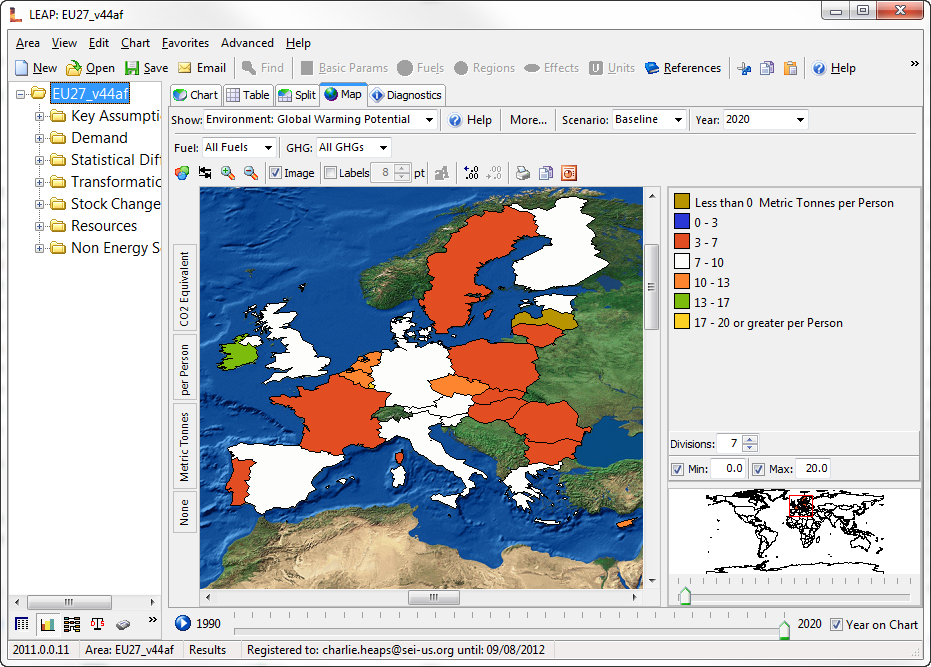SEI releases major new version of climate mitigation planning software
Press release: 10 May 2011
The Stockholm Environment Institute (SEI) has released a major new version of LEAP, the Long range Energy Alternatives Planning system, its powerful, versatile software system for integrated energy planning and greenhouse gas (GHG) mitigation assessment.
SOMERVILLE, MA - LEAP is already used by thousands of organizations in over 190 countries, including government agencies, academics, non-governmental organizations, consultants, and utilities, and is becoming the de facto standard for countries undertaking GHG mitigation assessments and creating Low Emission Development Strategies (LEDs).
The new release, LEAP2011, is more streamlined and easier to use than previous versions, but also adds significant new capabilities. For example, it includes optimization modeling – a technique that automatically calculates least-cost configurations of future energy systems under different conditions, such as specific GHG emission reduction targets. This capability, developed in partnership with organizations including the International Atomic Energy Agency (IAEA), the United Nations Industrial Development Organization (UNIDO), the UK Energy Research Center, and the Royal Technical University of Sweden (KTH), was previously limited to expensive and highly complex software systems.
“The new version of LEAP targets energy analysts who need more sophisticated analytical tools but who find existing software much too difficult and much too expensive to be practically useful,” said Charles Heaps, Ph.D., lead developer of LEAP.
LEAP2011 also includes more powerful tools for modeling seasonal and time-of-day variations in energy demand and supply, a crucial feature as energy planners seek to dramatically increase the share of power generated from renewable sources. The intermittent nature of solar and wind power, especially, will require such systems to be able to cope with much greater supply variability.
“These new features are vital in allowing energy models to better assess policies that can encourage the rapid adoption of clean renewable energy systems, energy efficiency and demand-controlling smart grids,” Heaps said. “We hope that energy planners will take advantage of this new version of LEAP to start planning the type of systems needed for a low carbon future.”
In addition to these new features, LEAP’s code has been substantially reengineered, making it faster and more robust, allowing it to fully support any language (including those with complex characters like Chinese, Japanese, and Russian) and supporting the planned future development of new capabilities such as multi-user and web-based versions of LEAP.
LEAP2011 also has a simplified, easier-to-use interface, with wizards that provide step-by-step assistance to users. Check-as-you-type error checking has been added to help users quickly identify and fix problems in the models they create. For users of previous versions, LEAP2011 allows for a seamless transition, with datasets safely backed up and automatically upgraded.
SEI distributes LEAP free of charge to governments, universities, and not-for-profit organizations in the developing world and to students worldwide. Consulting companies, utilities and other businesses can also get access to LEAP through affordably priced licensing arrangements.
Recent applications of LEAP include planning by the State of Massachusetts to cut GHG emissions 80% by 2050 and the development of a long-term climate agenda for Mexico through a partnership between the World Bank and the government of Mexico. Friends of the Earth also used LEAP in a study that showed how Europe could be a leader in addressing climate change by making rapid GHG emissions reductions.
LEAP is developed at SEI’s U.S. Center, at Tufts University in Somerville, MA. To learn more or to download LEAP2011, visit www.energycommunity.org.
Media contacts:
Charles Heaps, Ph.D. - lead developer of LEAP: +1 (617) 627-3786 charlie.heaps@sei-us.org
Ylva Rylander - SEI Head of Communications: +46 (0)73-150 33 84 ylva.rylander@sei.se
Stockholm Environment Institute is an independent international research institute. The Institute has established a reputation for rigorous and objective scientific analysis in the field of environment and development. SEI’s goal is to bring about change for sustainable development by bridging science and policy. Further information at www.sei-international.org
Tags:




